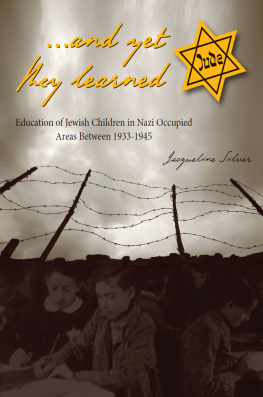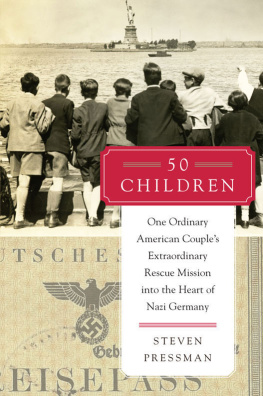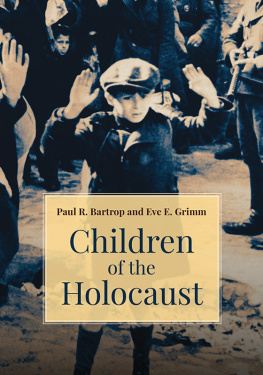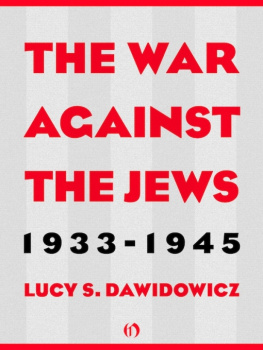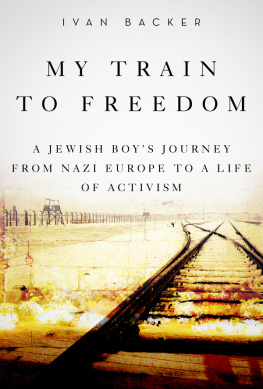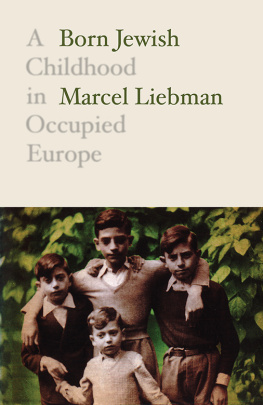
...AND YET THEY LEARNED

...AND YET THEY
LEARNED
Education of Jewish Children in Nazi Occupied
Areas Between 1933-1945
JACQUELINE SILVER
Education of Jewish Children in Nazi Occupied Areas Between 1933-1945.
Copyright by Jacqueline Silver in the United States of America. All rights reserved.
United States Copyright Registration Number TX-8-100-220. September 11. 2015
ISBN-13: 9781537796352
ISBN-10: 1537796356
Library of Congress Control Number: 2016916036
CreateSpace Independent Publishing Platform
North Charleston, South Carolina
Cover design by Geoff Archer.

PREFACE
T he research for this book looked at the efforts to educate Jewish children who lived under Nazi occupation in Europe and North Africa between 1933 and 1945. My research question asks, what are the important factors that relate to understanding the improvised, and generally clandestine, education of Jewish children during the Shoah in German occupied-areas between 1933 and 1945. My goal has been to offer answers to the questions who, what, where, how, and why Jewish children received education and how we might apply this knowledge to contemporary educational settings. The information has been retrieved from multiple sources in order to gain a comprehensive understanding not only of how Jewish children were educated but also the effects of this education on them emotionally, physiologically, socially, and morally. Children who lived in Germany during the rise of National Socialism and later in German ghettos and concentration camps, in orphanages, forests, or hidden in Christian homes, convents, and monasteries, dealt with constant fear, trauma, hunger, and other terrible conditions. This work shows that despite severe restrictions and enormous hardship there often were adults who took responsibility for providing children with schooling that gave them a semblance of normality and contributed to their lives in other ways. The conditions under which children lived during this period, the treatment they received from the adults with them, and their activities often determined, to a great extent, their survival and even conditions of their later lives. Data for this study were retrieved from several sources in order to corroborate historical information. It has come from biographies and memoirs, articles, documentary films, archived videotaped interviews of survivors, as well as interviews conducted by the author.
Key Words: Shoah, National Socialism, schooling

ACKNOWLEDGEMENTS
T his book would not have been possible without the love and encouragement I received from my maternal grandparents, Chaya Leah Metzger Greenberg, zl and Shaya (Samuel) Greenberg, zl. During all the years of my youth and adolescence they constantly reminded me of my worth and ability. Although they have been gone for many years, their words still echo in my mind and inspire me to continue following my dreams and, to the best of my ability, to be a mensch.
I deeply appreciate the support of my daughters Elisabeth and Stacy and my son-in-law Geoff Archer. Throughout this project they have understood the subject and my passion for it, and consistently expressed confidence that I would accomplish the goal. Importantly they spent many hours discussing the information and helping give clarity to historical events that still remain difficult to understand.
I want to thank Dr. Phoenix Raine at Antioch University Seattle who was a goldmine of information, advice, encouragement, and wonderful humor throughout the Masters Thesis inquiry that was the initial part of this project. At Fielding Graduate University Four Arrows (aka Don Trent Jacobs) was my guiding light throughout my doctoral program. I will be forever grateful for his interest and advice, which began at the beginning and never wavered. I am indebted to the faculty at Fielding Graduate University who were interested in my topic and shared their deep knowledge with me. To my Dissertation Committee, Four Arrows, Kitty Epstein, Rodney Beaulieu, Pandora Mike and Arthur Shostak, I extend many thanks for reading and advising me on this work throughout the stages from proposal to the end product.
Outside of my family and academics, others have offered information, advice, and materials. In the spirit of academic and historical integrity several researchers of the Shoah either shared their information or helped me to find what I needed. Rachelle Goldstein and her staff at The Hidden Child / Anti-Defamation League, supplied me with copies of The Hidden Child and photos from their archives as well as helping me connect with survivors who had been hidden children during the Shoah. The Washington State Holocaust Education Resource Center staff provided me with materials and a wealth of suggestions based on their vast experience with Shoah survivors. Esther Brumberg and Dganit Katz Yefit of the Museum of Jewish Heritage of New York City provided help in accessing survivor testimonies from that museums collection. Staff of the United States Holocaust Memorial Museum Resource Center provided useful materials for interviewing survivors of the Shoah. Their guidelines were invaluable for conducting my own interviews with survivors. At the Ghetto Fighters Kibbutz Museum Library in northern Israel, librarian Dafna Itzkovich took time to help me find critical information for this work.
Dr. Anna Kohn, President of the Albanian Jewish Womens Organization kindly shared my request for information with other members of the Albanian Jewish community who, in turn, shared their experiences with me. One of Dr. Kohns contacts, Saimir Lolja, President of the Albanian-Canadian Community Association, provided me with background information as well as information from his own contacts in the Albanian academic community. Dr. Lolja shared much of the material about Albania under German occupation.
I am deeply grateful to survivors who generously took time to share memories of their traumatic childhoods. In this way they either added new information or corroborated already published accounts and, most of all, helped add to understanding at least somewhat, of a very tragic period in history and its consequences for children.
Names of those interviewed by others and by myself are included in the list of References.
In the darkest moments, we still
have the right to expect some illumination which may well come less from theories and concepts than from the uncertain, flickering, and often weak light that some men and women, their lives and their works, will kindle under all circumstancesEyes so used to darkness as ours will hardly be able to tell whether their light was the light of a candle or that of a blazing sun. But such objective evaluation seems to me a matter of secondary importance which can be safely left to posterity.
(Hannah Arendt in a speech honoring Karl Jaspers in 1958,
Stranger From Abroad: Hannah Arendt,
Martin Heidegger, Friendship and Forgiveness
by D. Maier-Katkin, 2010)
TABLE OF CONTENTS
LIST OF FIGURES
Chapter 1
Next page
